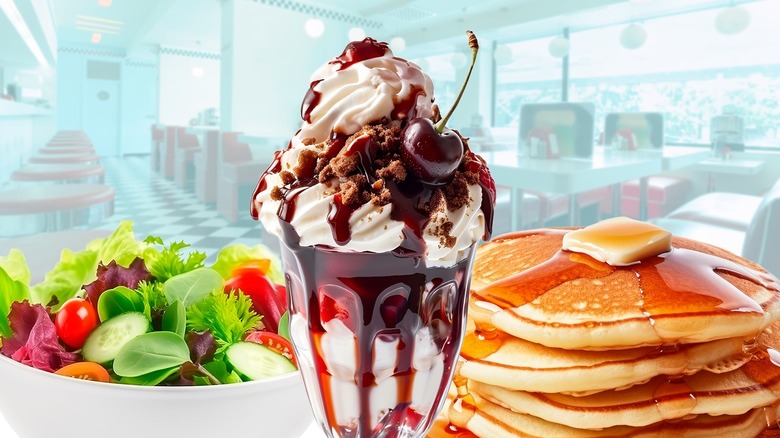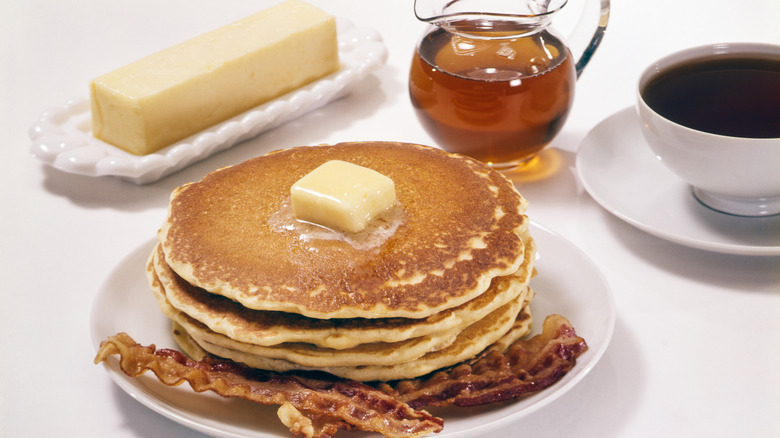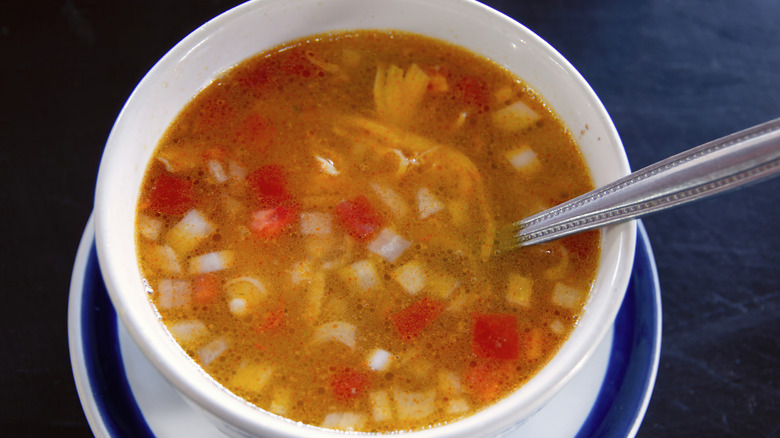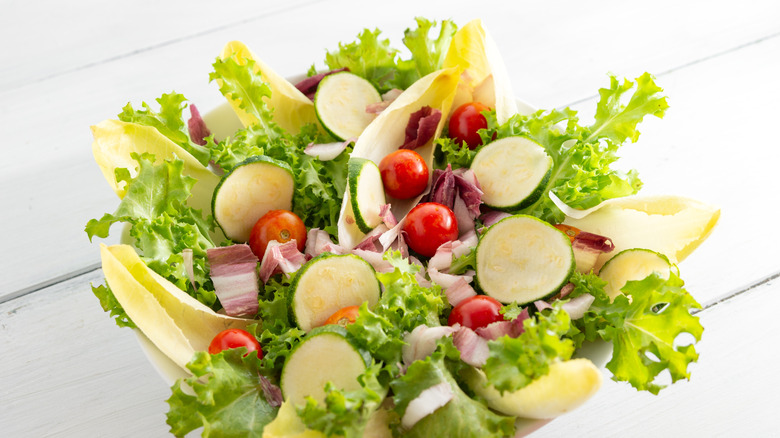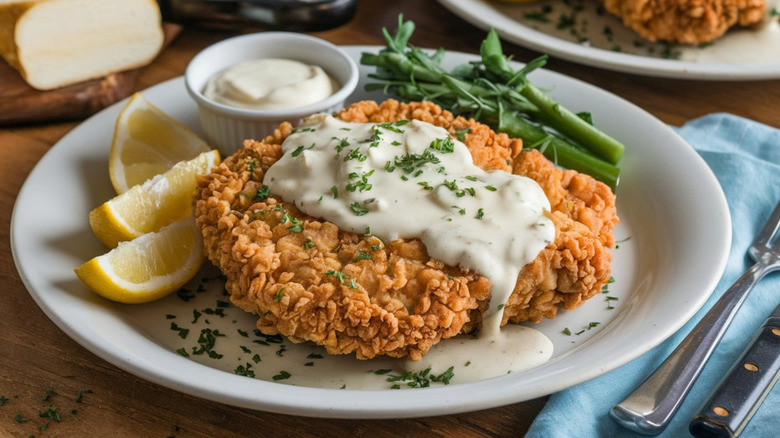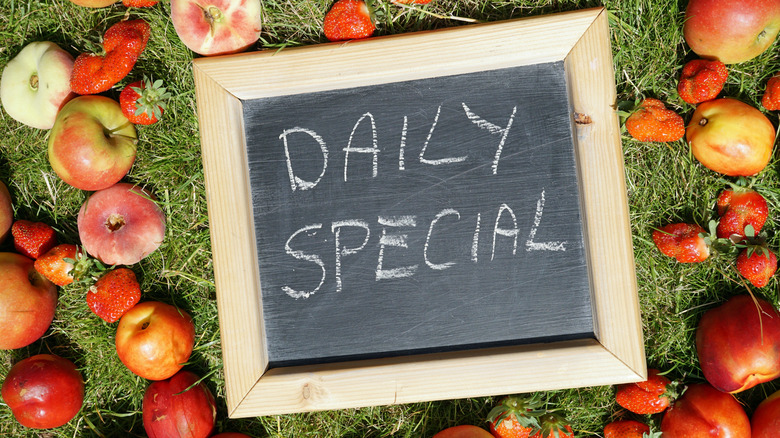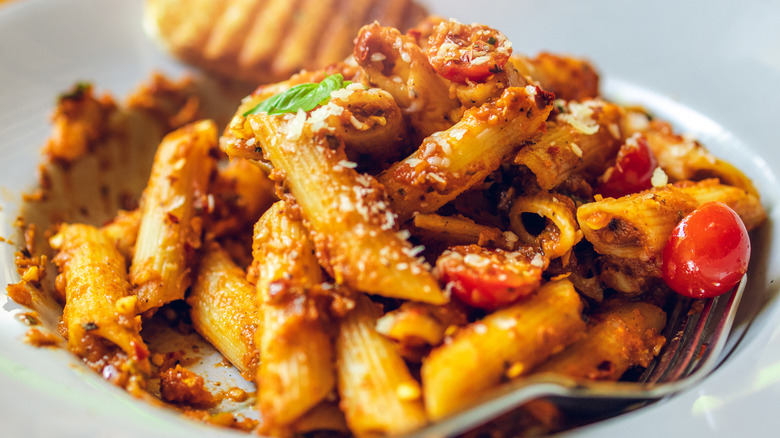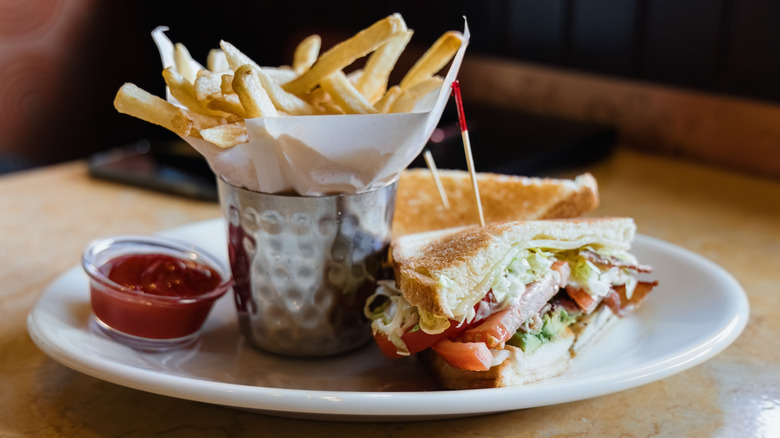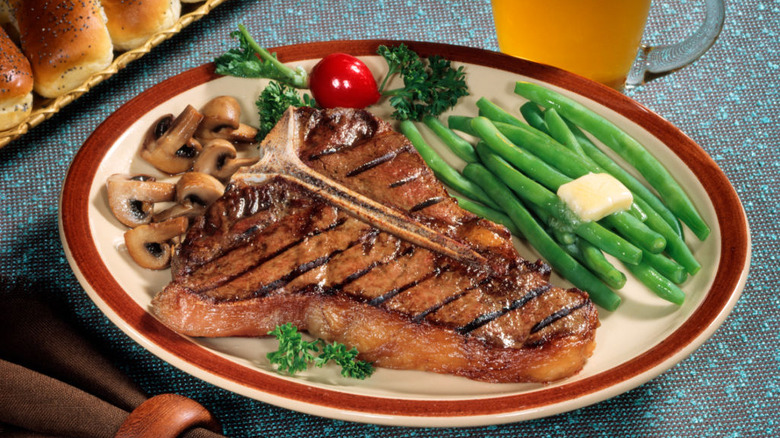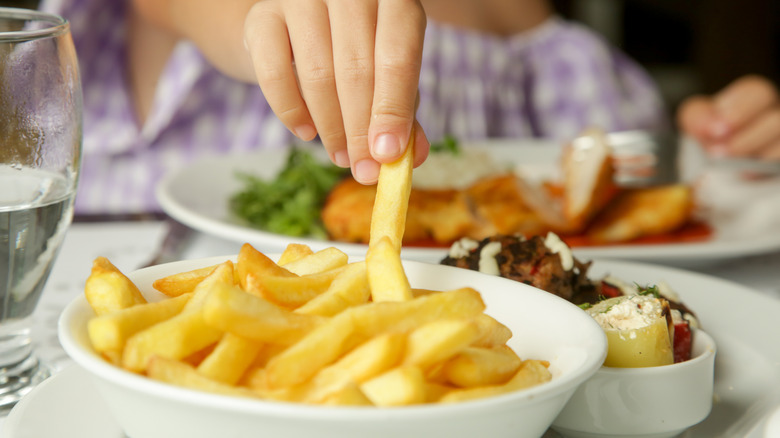6 Foods To Order When You're At A Diner And 5 To Avoid
Who doesn't love a good diner? Flickering neon signs, the sizzle of a flat top griddle, the steaming hot mug of coffee, and your favorite slice of pie. Diners are comfort food at its peak, and part of the charm is knowing what you order will not surprise you. But, here's the thing: just because you know what to expect doesn't mean that every item is worth ordering. A good diner meal is about reliability, satisfaction, and speed. These are the kind of dishes line cooks can make with their eyes closed because they churn them out on repeat. That's why some diner food items are classics that never go out of style. They involve simple ingredients, techniques, and the muscle memory of chefs who have perfected them over time. Order any of these, and you're guaranteed a great meal.
On the flip side, other menu items may fall short. Vintage diner foods that aren't popular anymore, steak dinners that arrive overcooked, or unappealing salads that have seen better days. Sometimes the soup of the day is inspired, but more often than not, these specials are meant to move produce that didn't sell. The reason we go to diners is for reassuring, reliable comfort food, not wild flavors or trendy dishes. Consider this your road map to what to order with confidence and what to skip without any regret.
Order: Pancakes
You aren't imagining it. Pancakes at a diner typically taste better than the ones you make at home. (Although it only takes three ingredients to whip up your own pancakes.) For many, flapjacks are the heart of the diner ritual. Settling in with your cup of coffee and waiting to dig into that fluffy stack drizzled with syrup and butter is the highlight of the experience.
There are several reasons why diner pancakes are better. First off, restaurants aren't light-handed with the good stuff. Diner pancakes tend to have significantly more butter, sugar, and tangy buttermilk than what you'd use in your kitchen. This makes the batter richer and the mouthfeel more enjoyable. Diners also cook on seasoned flat top griddles, which are basically built-in flavor bombs. Your non-stick pan at home doesn't stand a chance.
Some diners add malted milk powder to their flapjack mix, which adds a tempting, nutty sweetness. Then of course, there's the sheer volume. A line cook at a busy diner will make tons of pancakes a day. That repetition alone will build skill and consistency, resulting in perfectly uniform, fluffed-up layers. Diner cooks know how much to mix the batter for the airiest cakes and when to flip them for golden perfection. Even if the establishment uses a commercial mix, repetition paired with fresh eggs and milk will invariably result in reliable and delicious pancakes.
Avoid: Soup of the Day
Something warm and filling, like a steaming bowl of soup, seems like a good idea and is also easy on the pocket. However, you won't always get what you expect, and in this case, the truth might cause you to lose your appetite. The soup of the day is often a great way for restaurants to utilize their leftovers. Extra veggies, scraps of meat, and yesterday's chicken are thrown into a pot and left to simmer. It does help to reduce wastage, but it also means that you may end up eating a hodgepodge of not-so-fresh ingredients. Chef Gordon Ramsay's advice is to ask about yesterday's soup of the day. If it's the same as today's, he suggests you skip it.
Another red flag is if the daily soup menu rarely changes. An ideal soup of the day should reflect fresh and seasonal ingredients along with the chef's expertise and ingenuity. If a diner only serves up tomato soup or chicken noodle, there's a chance that it's been ladled out of a can. These versions are usually loaded with sodium and preservatives and not really the homemade, nutritious bowl we're hoping for. Of course, not all soups are bad. At reputable diners, a local specialty like gumbo or bisque could be a standout. But at many establishments, what you're actually ordering is reheated leftovers.
Order: Patty Melt
Pancakes may be a diner breakfast staple, but the lunchtime star is hands down the patty melt. Proof that simple ingredients can be transformed into the best meals, the patty melt pairs a beef patty with Swiss cheese, caramelized onions, and rye bread. The entire creation is then grilled to golden perfection. A mashup of a cheeseburger and a grilled cheese sandwich, the patty melt delivers all the familiar comfort you crave, along with a delectable crunch in every bite.
A taste of pure Americana, the patty melt originated in the late 1940s at Tiny Naylor's coffee shops and drive-ins. Before long, it was a diner staple from coast to coast. Unlike burgers, where toppings and buns have morphed with the times, the patty melt is famed for its consistency. You know exactly what you're getting when you order one. And at a diner, it reaches you crisp from the flat top grill, oozing with cheese and butter. What makes it a must-order isn't just about nostalgia and dependability. A good patty melt is often a great indicator of an establishment's quality. If your sandwich arrives with slowly caramelized onions, a slice of melted Swiss cheese, and beef cooked just right, you'll know you're in good hands. In other words, the diner patty melt isn't just a lunch sandwich; it's a benchmark diner specialty.
Avoid: Salads
As restaurant-goers increasingly make more health-conscious choices, salads have become a popular alternative to traditional meals at diners. While a salad may seem like a good break from the typical fare, it might be the worst item on the menu. Firstly, you have to consider food safety. According to the CDC, leafy greens are one of the most common carriers of foodborne diseases. Greens risk contamination at every point of their journey from the field to your plate, and since they are served raw, the bacteria live on — even if the veggies have been pre-cut and bagged.
Slimy arugula, limp iceberg lettuce, and wrinkled tomatoes are all signs that your salad has seen better days. The greens on your plate are likely some of the least expensive ingredients in the kitchen, but they've been marked up substantially when served as a salad. With some added cheese and dressing, you end up paying an unreasonable amount for nothing more than a hyped-up plate of veggies. A salad is not necessarily a nutritious option, either. If it's loaded with cheese, dressing, and deep-fried proteins, the salad probably has just as many, if not more, calories and unhealthy fats as other meals. So, unless you know for a fact that the diner's greens are fresh, skip the salad and give your stomach and wallet a break.
Order: Chicken-Fried Steak
For Southern comfort at its finest, don't miss out on the chicken-fried steak the next time you're at a diner. Despite the name, chicken-fried steak does not contain chicken. What you'll actually get is a tender cut of steak that has been dipped in seasoned flour, dunked in egg or buttermilk, dredged through the flour again for extra crunch, then fried till golden brown. The process is similar to how you'd prepare fried chicken, hence the name.
This intriguing dish has roots that can be traced back to the early wave of Austrian and German immigrants to the United States. Adapting their beloved Wiener schnitzel to local ingredients, the recipe soon began turning up in cookbooks and restaurants across the country. There's even a Chicken Fried Steak Day celebrated in Texas, a testament to the fan following this plate inspires.
What makes it a must-have is the balance between the well-seasoned breaded crust and the juicy steak inside. The typical accompaniments take this dish to the next level. Sides can include creamy gravy spooned over the top, mashed potatoes, fried okra, and a biscuit. For breakfast, you can even enjoy chicken-fried steak with a fried egg and hash browns. Whatever you choose, it makes for a hearty, affordable, and deeply satisfying meal.
Avoid: Daily Special
The daily special implies a dish with singular quality, something apart from the regular menu fare. Ordering a diner's daily special might seem like a good idea, a chance to try something different for a change. But different doesn't necessarily mean better, and in the diner, this special is often a gamble.
In some cases, the chef may offer a really creative dish with seasonal ingredients, but the special is usually focused on using up leftovers. Advertising it as a special helps move products that are potentially going bad, not unlike supermarkets selling nearly expired products at steep discounts. Chefs have many ways of disguising the fact that the ingredients have been sitting around for a while. A little extra seasoning, a heavier sauce, or a slow cooking process will leave you none the wiser. Seafood specials, in particular, are best to avoid. Since restaurants rarely get deliveries on Sundays, the seafood special on a Monday is probably last week's goods. Pricing is also an important consideration. Many daily specials will come at a higher price than the normal menu items. It's a good tactic, playing on the customer's psychology to make them believe they are getting a higher-quality meal. But the reality may be different, so it's best to skip the specials.
Order: Milkshakes
Can you imagine a diner meal without a milkshake? Burgers and fries may hold their own, but a creamy, rich, and thick milkshake is the true star of a diner's menu. What sets a diner milkshake apart is its decadence. The dessert is always refreshingly cold and satisfyingly sweet. A diner milkshake feels like it was made with the best ice cream, melted and whipped up, achieving the kind of texture that most struggle to recreate at home. Most diners create this treat with heavy-duty blenders or milkshake mixers, which effortlessly whip air into the ice cream and milk for that perfectly smooth finish. Add in the chilled glassware, the vintage mixer cups, and the nostalgic ambiance, and you have a dessert that no home kitchen can rival.
Milkshakes probably come from another sweet beverage called malted milk. Throughout the early 20th century, malted milk got upgraded with the addition of ice cream and the widespread use of refrigeration. Suddenly, these frozen treats were a national classic, accessible to all and a symbol of youth. Teens across the country hung out at local diners and enjoyed a milkshake or two throughout the day. In more recent times, you can find milkshakes made without ice cream or freakshakes piled high with brownies, candy, and towers of cream to appeal to your Instagram feed. However, the diner milkshake still retains its classic appeal. Chocolate, vanilla, or strawberry is all you need for a sweet indulgence.
Avoid: Pasta
Ordering pasta at a diner seems like a no-brainer. After all, who wouldn't love a delicious, cheesy pasta paired with a sauce of their choice? It's something that goes down easily and keeps your taste buds and tummy happy. This could be true at restaurants, but at a diner, you might be making a big mistake. That's because most diners' menus primarily consist of items like burgers and meatloaf, meaning the pasta dish is more of an afterthought.
If you order pasta at a diner, you shouldn't expect a quality sauce cooked over a slow fire and infused with garlic, herbs, and onions. Instead, thanks to limited time or resources, it's possibly sat in plastic tubs and been reheated several times. This could make the sauce taste flat, sour, or salty. Of course, if they happen to use a jarred sauce, it could be loaded with additives. To top it off, the pasta will probably end up costing as much as a burger, which would have been a more satisfying option. It's not that all diners serve poor-quality pasta. An Italian diner that specializes in family recipes would undeniably be a treat. Otherwise, you should avoid the pasta dish at regular diners. Keep those cravings on hold until your next visit to an Italian restaurant.
Order: Club Sandwich
Who would have thought that a few simple ingredients slapped together in between slices of toasted bread could turn into a cultural icon? The club sandwich is humble yet indulgent, an architectural marvel of three layers of bread and sliced turkey or chicken, finished with some veggies that give it an irresistible crunch.
The origins of this triple-deckered dish are debated. Some say it can be traced back to the late 1800s from Saratoga Springs, while others argue that the dish has its roots in England. By the 20th century, however, the sandwich had become a fixture on all fancy clubhouse menus in the United States. Soon after, it made its way to diners across the country and became accessible to everyone. What makes the club sandwich so stellar is the simplicity of its ingredients. The three slices of bread are toasted just right — crisp enough to hold the structure but not too toasty to shatter on the first bite. Juicy tomatoes, crunchy lettuce, and a creamy layer of mayonnaise seal the deal. The bacon must be crisp, and the middle piece of toast is essential to hold everything together. Today, there are many novel variations, including the bolgna club sandwich. Nevertheless, at its core, the classic diner club is balanced, filling, and nostalgic — hitting all the marks for the best diner food.
Avoid: Steak
Before ordering steak at a diner, you need to understand that you'll probably get a cut of meat that isn't top-notch. Some diners source the cheapest cuts of beef, meaning you usually won't find ribeye or tenderloin on the menu. As a result, your steak meal may be a forgettable experience, apart from the chewiness and unnecessary jaw workout.
Most chefs will tell you that a good steak requires proper sourcing and skillful cooking, something typically beyond the repertoire of diner kitchen staff. Instead, diner kitchens are more accustomed to churning out fried foods and flat top favorites. This is maybe why diner steaks often come doused in marinades, sauces, or rubs, all in an attempt to hide the poor quality of the meat. Thanks to their lower prices, diner steaks may seem like a bargain, especially compared to those at a steakhouse. However, this cheaper price tag could indicate lower quality and smaller portion sizes. If you're expecting a heaping steak dinner, be prepared for disappointment. The size and quality will probably leave you underwhelmed.
Order: French Fries
When you order a basket of fries at a diner, you receive a pile of crispy perfection that no oven or air fryer can match. The best diner fries are golden on the outside and soft and fluffy inside. Order them as the ultimate sidekick to your burger or club sandwich, or dunk them into your milkshake.
The secret to perfect fries lies in the technique, and the best diner kitchens will use a two-step method. This means the potatoes are fried twice, first in a low-temperature oil bath, then in a hotter one to achieve that inimitable crunch. Even if the establishment uses frozen and parboiled fries, the magic lies in using oil that maintains a steady, high heat, so that every batch comes out consistently crunchy. At home, most of us lack the necessary equipment or patience to recreate this crunch. Other crucial details include sourcing the right potatoes (usually russets for their high starch content) and using the proper neutral oil with a high smoke point. Seasoning at just the right moment also ensures that the salt clings to every crispy edge. While some restaurants may experiment with herbs, spices, and fancy toppings, there's a delicious nostalgia to the classic plate of French fries sprinkled with salt and served hot.
